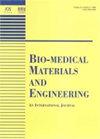可移动全膝关节置换术股骨假体矢状位对准的有限元分析。
IF 1
4区 医学
Q4 ENGINEERING, BIOMEDICAL
引用次数: 3
摘要
最近,人们对可移动全膝关节置换术(TKA)的兴趣越来越大。然而,移动轴承TKA股骨假体对齐的生物力学变化尚未深入探讨。目的评价在可移动全髋关节置换术中股骨假体矢状面对准的生物力学效果。方法我们建立了-3°,0°,3°,5°和7°屈曲的股骨矢状位对齐模型。我们还使用一个经过验证的计算模型,在膝关节深度弯曲的情况下,研究了胫股关节(TF)的运动学、TF关节的接触点、髌股关节(PF)的接触应力、副韧带力和股四头肌力。结果TF关节的后运动学随着股骨假体屈曲而增加。股骨关节屈曲时,PF关节上的接触应力、副韧带力和股四头肌力减小。结论植入体的轻微屈曲(约0°~ 3°)是一种有效的替代技术。然而,由于潜在的TF关节松动,应避免过度屈曲。本文章由计算机程序翻译,如有差异,请以英文原文为准。
Finite element analysis of femoral component sagittal alignment in mobile-bearing total knee arthroplasty.
BACKGROUND
Recently, there has been an increasing interest in mobile-bearing total knee arthroplasty (TKA). However, changes in biomechanics for femoral component alignment in mobile-bearing TKA have not been explored in depth.
OBJECTIVE
This study aims to evaluate the biomechanical effect of sagittal alignment of the femoral component in mobile-bearing TKA.
METHODS
We developed femoral sagittal alignment models with -3°, 0°, 3°, 5°, and 7° flexion. We also examine the kinematics of the tibiofemoral (TF) joint, contact point on the TF joint, contact stress on the patellofemoral (PF) joint, collateral ligament force, and quadriceps force using a validated computational model under a deep-knee-bend condition.
RESULTS
Posterior kinematics of the TF joint increases as the femoral component flexes. The contact stress on the PF joint, collateral ligament force, and the quadriceps force decreases as the femoral component flexes.
CONCLUSIONS
Our results show that a slight, approximately 0°∼3°, flexion of the implantation could be an effective substitute technique. However, excessive flexion should be avoided because of the potential loosening of the TF joint.
求助全文
通过发布文献求助,成功后即可免费获取论文全文。
去求助
来源期刊

Bio-medical materials and engineering
工程技术-材料科学:生物材料
CiteScore
1.80
自引率
0.00%
发文量
73
审稿时长
6 months
期刊介绍:
The aim of Bio-Medical Materials and Engineering is to promote the welfare of humans and to help them keep healthy. This international journal is an interdisciplinary journal that publishes original research papers, review articles and brief notes on materials and engineering for biological and medical systems. Articles in this peer-reviewed journal cover a wide range of topics, including, but not limited to: Engineering as applied to improving diagnosis, therapy, and prevention of disease and injury, and better substitutes for damaged or disabled human organs; Studies of biomaterial interactions with the human body, bio-compatibility, interfacial and interaction problems; Biomechanical behavior under biological and/or medical conditions; Mechanical and biological properties of membrane biomaterials; Cellular and tissue engineering, physiological, biophysical, biochemical bioengineering aspects; Implant failure fields and degradation of implants. Biomimetics engineering and materials including system analysis as supporter for aged people and as rehabilitation; Bioengineering and materials technology as applied to the decontamination against environmental problems; Biosensors, bioreactors, bioprocess instrumentation and control system; Application to food engineering; Standardization problems on biomaterials and related products; Assessment of reliability and safety of biomedical materials and man-machine systems; and Product liability of biomaterials and related products.
 求助内容:
求助内容: 应助结果提醒方式:
应助结果提醒方式:


